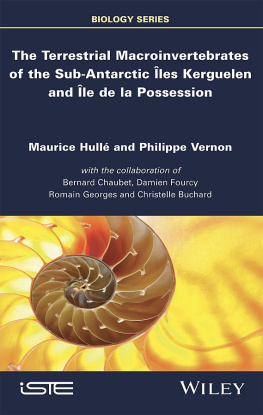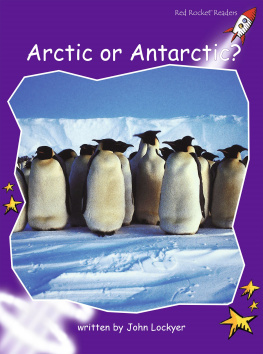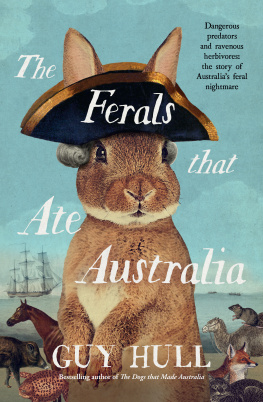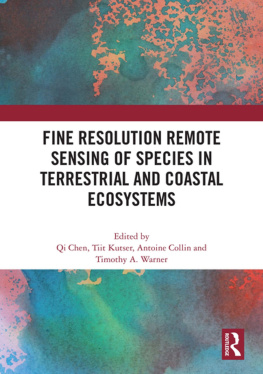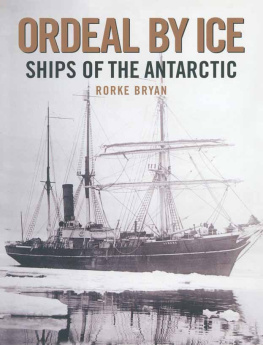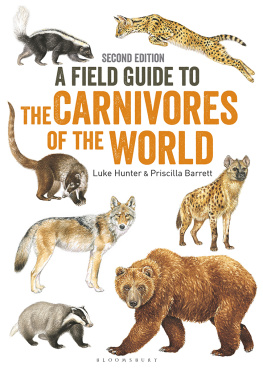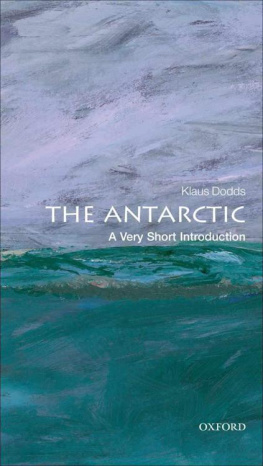
Series Editor
Marie-Christine Maurel
The Terrestrial Macroinvertebrates of the Sub-Antarctic les Kerguelen and le de la Possession
Maurice Hull
Philippe Vernon
with the collaboration of
Bernard Chaubet
Damien Fourcy
Romain Georges
Christelle Buchard

First published 2021 in Great Britain and the United States by ISTE Ltd and John Wiley & Sons, Inc.
Apart from any fair dealing for the purposes of research or private study, or criticism or review, as permitted under the Copyright, Designs and Patents Act 1988, this publication may only be reproduced, stored or transmitted, in any form or by any means, with the prior permission in writing of the publishers, or in the case of reprographic reproduction in accordance with the terms and licenses issued by the CLA. Enquiries concerning reproduction outside these terms should be sent to the publishers at the undermentioned address:
ISTE Ltd
27-37 St Georges Road
London SW19 4EU
UK
www.iste.co.uk
John Wiley & Sons, Inc.
111 River Street
Hoboken, NJ 07030
USA
www.wiley.com
ISTE Ltd 2021
The rights of Maurice Hull and Philippe Vernon to be identified as the authors of this work have been asserted by them in accordance with the Copyright, Designs and Patents Act 1988.
Library of Congress Control Number: 2021937387
British Library Cataloguing-in-Publication Data
A CIP record for this book is available from the British Library
ISBN 978-1-78630-760-6
Photography: Bernard Chaubet (INRAE)
Cartography: Damien Fourcy (INRAE)
Species identification: Romain Georges (University of Rennes 1), Christelle Buchard (INRAE)
Foreword 1
The extraordinary American conservationist and thinker Aldo Leopold wrote: To keep every cog and wheel is the first precaution of intelligent tinkering. To keep every cog and wheel presupposes that each one of them is not only known but can also be identified. For most places, knowing the full diversity of life is only imaginable. And for most people, identifying that diversity is unthinkable. Yet, a few specially endowed naturalists seem to be able to do so. And because they are often too little valued in our modern scientific world, their knowledge passes with them into history. Thus, places and the people who value them frequently fall into a cycle of knowing and forgetting.
Yet, every now and then, naturalists and writers come along who are determined to break that cycle. They recruit, through a combination of tenacity, charm and a fierce love for a place and its diversity, a host of helpers. Spurred on by the positive feedback that comes from enthusiasm, they recruit even more extensively. Eventually, they deliver a monograph of life. A record of a places diversity and the means for others to know it in all of its exquisite detail. In doing so, they make forever known a part of our world that would otherwise have remained trapped in that cycle of light and dark.
Here, Maurice Hull and Philippe Vernon have done just this for the larger invertebrates of the extraordinary sub-Antarctic islands of the les Kerguelen and the le de la Possession.
Doing so could not have been easy. Scattered knowledge is one thing. But finding the animals to verify the knowledge and to captivate the attention of new recruits is quite another. The sub-Antarctic islands are simply gorgeous and apparently teeming with life. Yet, most are no longer what they once were. On islands free of introduced species such as rodents, cats, carnivorous beetles, herbivorous slugs and system-altering weeds the abundance of invertebrates is extraordinary. Beetles, moths and other insects are simply everywhere, even in the apparently hostile habitats such as fellfields. The coastal zones no longer stand out as special because of their abundance of insects (notably some very strange flies). Yet on islands such as the les Kerguelen and the le de la Possession, where introduced species have had much time to do their work, abundances, except of the introduced species and some coastal inhabitants, are very low. Low to the point of thinking that some species have gone forever. Yet, often they have not. It simply takes a great deal of work to find them. And a very special talent of combining relentless enthusiasm for hard field work and exceptional charm to keep people coming back in search of knowledge, to look at more specimens and answer more questions. Questions that can be remarkably uncomfortable to ensure that the knowledge is secure.
Such tenacity, a characteristic of the authors, results in a handsome reward, and this monograph of the larger terrestrial invertebrate life of these islands is just such a reward. How extraordinary to have this work. The question I wonder what this is? is answered readily. And with that question addressed, immediately others can be posed. What does it do? What is its history of abundance? What is its future? How do we mitigate further change?
The sub-Antarctic islands are a global treasure. Most are recognized as such through their listing as World Heritage Sites. Here, we have a further record of the treasures of two of the most important island groups in the sub-Antarctic. As far as we can tell, and new genetic techniques are on the cusp of revealing, much of the terrestrial invertebrate diversity of the Indian Ocean sub-Antarctic islands originated here. In this respect, a history of accomplished French researchers, starting with Ren Jeannel, has been vital. These islands lie at the center of the evolutionary drama that is the sub-Antarctic. A drama that has captivated the minds of some of biologys greatest thinkers. Knowing the islands diversity and being able to recognize it places that drama and its actors within everyones grasp. Being able to tell the carabid beetles Amblystogenium minimum from Amblystogenium pacificum is now as easy as telling a Macaroni from a Rockhopper penguin.
The drama is not played out. The sub-Antarctic treasures face much difficulty because of introduced species, the local impacts of global climate change and what is now being increasingly documented as a positive effect of climate change on invasive species. If the play is not to end a tragedy, new actors are required; new actors with new parts. Parts that require thoughtful conservation action based on compelling evidence. In delivering this monograph, Maurice Hull and Philippe Vernon have changed the nature of the auditions. They have broadened the talent pool to everyone who has a love of life as we know it. And they have extended the audience too. Even those who have never come close to the theatres that are these islands can take part by having the islands diversity revealed.
This monograph is an exceptional tribute to the way in which good science, strong support for it and personal tenacity, enthusiasm and humor can be combined to deliver a lasting legacy. I recommend that as a reader you now plunge yourself into the world of sub-Antarctic terrestrial life, a world that, once seen, will never leave you. Cogs and wheels have never looked this good.
Steven L. CHOWN
Professor, Monash University
President, Scientific Committee on Antarctic Research
Melbourne, Australia
September 2020
Foreword 2
When confronted with a book about invertebrates of sub-Antarctic islands, we might expect a boring list written in a 19th-Century fashion by museum experts about their identification But the multidisciplinary state of the art of two modern field naturalists makes this book fascinating. Maurice Hull and Philippe Vernon have indeed been remarkably successful in providing a story on biodiversity, with nice iconography, which started in 1830 and is still evolving today.
Next page
